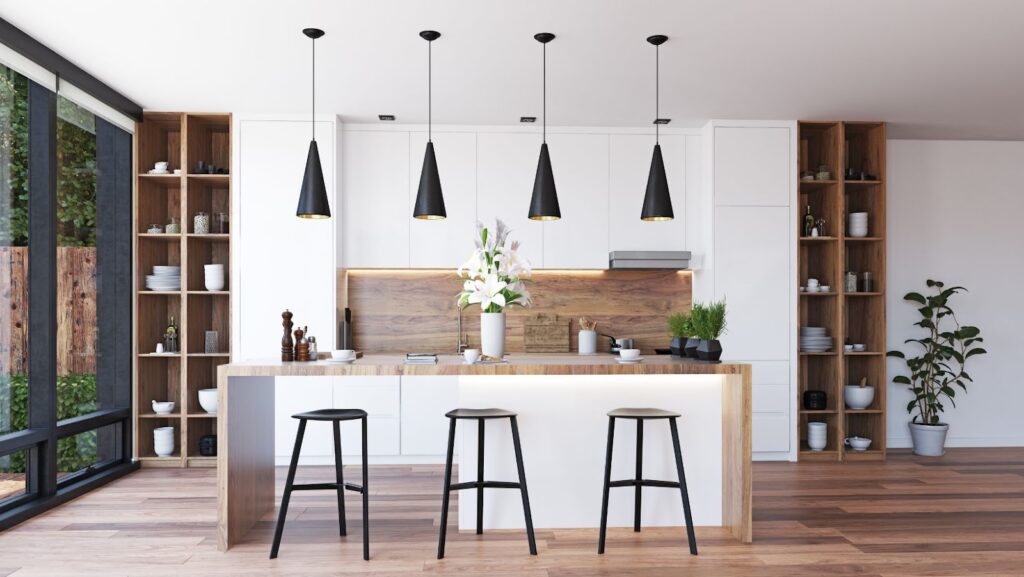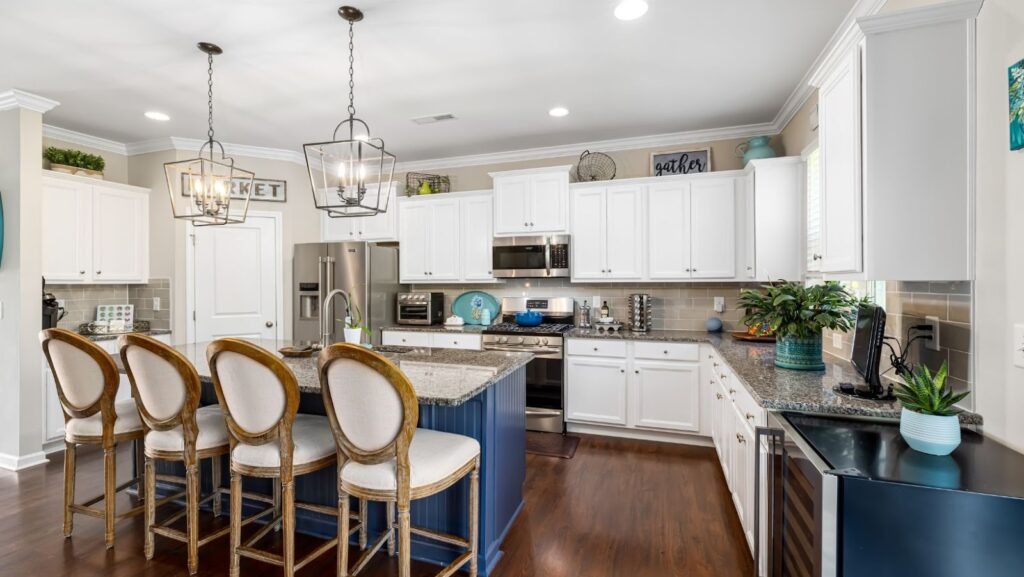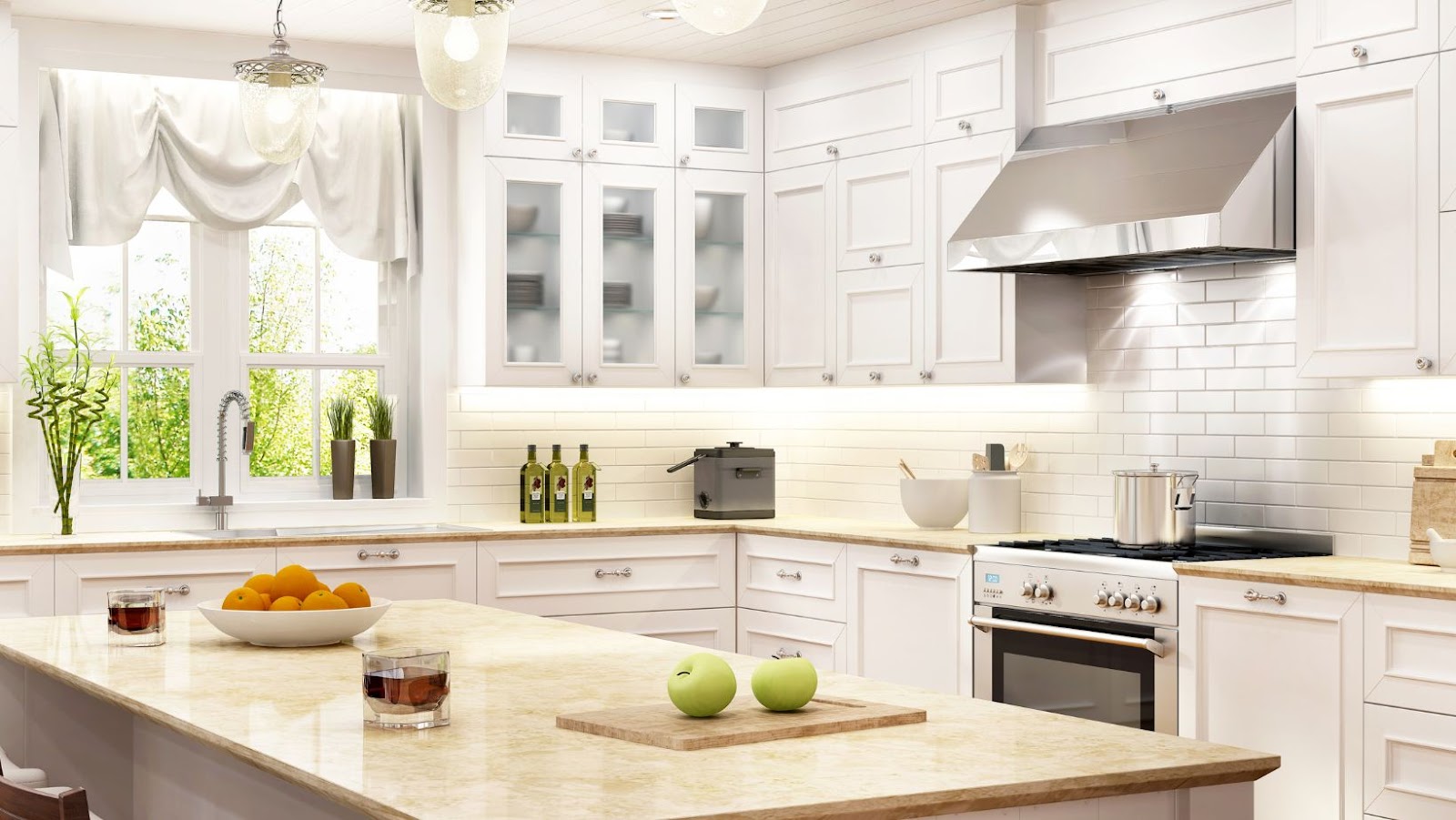The top Kitchen Island Trends for 2020
 One of the top trends for kitchen islands in 2020 is their size and shape. Kitchen islands are getting bigger and more multi-functional, serving as the centrepiece of the kitchen.
One of the top trends for kitchen islands in 2020 is their size and shape. Kitchen islands are getting bigger and more multi-functional, serving as the centrepiece of the kitchen.
How Big should a Kitchen Island be
Here is a guide on how big your kitchen island should be based on your kitchen size:
Small kitchen (less than 150 sq ft): It’s recommended to have an island no bigger than 24 inches wide and 36 inches long.
Medium-sized kitchen (between 150-300 sq ft): An island that’s between 24-30 inches wide and 48 inches long is optimal.
Large kitchen (over 300 sq ft): For a larger kitchen, an island that’s at least 36 inches wide and 72 inches long is recommended.
In addition to size, kitchen islands are also featuring bold colours, mixed materials, and clever storage solutions, such as built-in appliances and hidden trash bins.
Functional and Decorative Kitchen Islands
Kitchen islands are becoming a popular way to make use of available space as well as add a unique, stylish look to the kitchen. Not only do they provide additional countertop & cabinet space, but they also make the kitchen look bigger and brighter.
With the ever changing trends, we can look into the top trends for kitchen islands in 2020 and how big a kitchen island should be.
Kitchen Islands with Built-in Appliances
Kitchen islands with built-in appliances are becoming increasingly popular for their functionality and style. When it comes to determining the size of your kitchen island, it largely depends on the amount of space you have available and the intended use of the island.
A general rule of thumb is to aim for a width of at least 2.5 feet and a length of at least 4 feet, with a minimum clearance of 3 feet on all sides. This allows for ample counter space and comfortable seating, if desired. Additionally, the height of your island should be proportionate to the height of your countertops, which typically range between 36 and 42 inches.
Incorporating built-in appliances, such as a sink, stove, or oven, can add even more functionality and convenience to your kitchen island. This allows for easy meal preparation and cleanup, and can also act as a gathering spot for family and friends during social events.
Overall, the top kitchen island trends for 2020 emphasise functionality, convenience, and style to enhance the overall appeal and practicality of your kitchen.
Kitchen Islands with Storage Space
Kitchen islands with storage space are a great addition to any home, both functional and decorative. When considering the top kitchen island trends for 2020, it’s important to take into account the size of your kitchen island and the space it will occupy.
A kitchen island should typically be no less than 2 feet wide and 4 feet long for it to be functional. It is important to allow enough space for a comfortable flow of foot traffic around the island. However, the size of the island should also depend on the size of your kitchen space. A small kitchen might require a smaller island that can be easily moved around, while a bigger kitchen might allow for a larger, more permanent fixture.
When choosing a kitchen island with storage space, consider the style, design, and functionality that matches your home’s decor and your personal needs. A kitchen island with open shelves or closed cabinets can not only provide storage but also add character and charm to your kitchen.
Kitchen Islands with Seating
Kitchen islands with seating are a functional and decorative addition to any kitchen. When it comes to determining how big your kitchen island should be, it depends on the size of your kitchen, number of family members, and kitchen activities.
Here are the top kitchen island trends for 2020:

1. Bigger islands: Large kitchen islands are on-trend, providing more counter space, additional storage, and seating options.
2. Multi-level islands: This design adds visual interest to your kitchen and can accommodate different activities and tasks in one space.
3. Hidden storage: Incorporating smart storage solutions into your kitchen island can help you to keep your counters clutter-free.
4. Mixed materials: Combining different materials on your kitchen islands such as marble, wood, and steel is an up and coming trend.
5. Seating options: Consider the number of family members and how you will be using your island, to determine how much seating you require.
When deciding on the size of your kitchen island, make sure that it does not overcrowd your kitchen space and allows enough room for people to move freely around it. A general guideline is to allow at least 36 inches of clearance around each side of the island.
Materials and Colors for Kitchen Islands
When selecting a kitchen island, it’s important to consider the size, materials, and colours to ensure a good aesthetic fit for your space. In 2020, many of the top trends for kitchen islands have focused on bold colours, natural wood materials, and unique shapes.
In this article, we will be discussing the top materials and colours for kitchen islands and how big they should be.
The Rise of Dark-Colored Kitchen Islands
Dark-coloured kitchen islands are on the rise as a popular trend in kitchen design in 2020. These islands can be a striking focal point in your kitchen and add a sophisticated touch to the overall look.
When it comes to materials and colours for kitchen islands, dark or black cabinetry with contrasting countertops is a popular choice. Other popular colour trends for kitchen islands include shades of blue, green, and grey.
As for size, the ideal kitchen island size depends on the layout of your kitchen and your specific needs. Generally, an island should be at least 4 feet long and 2 feet deep, but it can be much larger if you have the space. Some homeowners opt for a multi-level island to create a unique design that combines workspace with seating. Ultimately, the size and layout should suit the flow and function of your kitchen.
Pro Tip: When choosing a colour scheme for your kitchen island, consider the overall colour palette of your kitchen and home. Go for a cohesive look that ties the elements together.
The Popularity of Natural Materials for Kitchen Islands
Natural materials are becoming increasingly popular in the design of kitchen islands due to their versatility and durability.
Some of the most popular natural materials for kitchen islands include:
1) Granite – Known for its resistance to scratches, heat and stains, granite countertops come in a wide range of colours and textures.
2) Marble – Famous for its unique veining patterns and smooth surface, marble is a high-maintenance material that requires regular cleaning and sealing to maintain its pristine look.
3) Wood – A warm and inviting choice, wooden island countertops add texture and depth to the kitchen design. It is important to choose a water-resistant wood such as teak, oak or walnut, and seal it with mineral oil to prevent damage from moisture.
4) Quartz – Durable, hygienic, and easy to maintain, quartz countertops are popular for their consistency in pattern and colour options.
Neutral colours such as beige, cream, and soft grey hues are dominating the kitchen decor trend. Also, the classic tones of black, white and navy blue are versatile and will always remain in style.
When choosing the right material and colour for your kitchen island, plan its usage, durability, compatibility with the rest of the kitchen, and of course, your personal style.
Innovative Finishes for Kitchen Islands
Innovative finishes for kitchen islands are available in a wide range of materials and colours, making it easy to find the perfect fit for your kitchen design. When planning for a kitchen island, one crucial thing to consider is the size that suits your kitchen. Here are the top kitchen island trends for 2020:
1. Two-Tone Islands: Two-tone kitchen islands, with contrasting colors between the countertop and base, are becoming increasingly popular.
2. Natural Wood: Incorporating natural wood finishes with a butcher block countertop adds warmth and texture to the kitchen.
3. Concrete: Concrete countertops add an industrial, contemporary edge to a kitchen island.
4. Colourful Islands: Colourful kitchen islands add a fun, unexpected element to any kitchen design.
When thinking about your island, consider its size and proximity to other kitchen elements. A kitchen island that is too big can limit movement and be an eyesore. A good rule of thumb is to aim for a width of around 3 feet and a length of 5-10 feet.
Sizing and Layout of Kitchen Islands
If you’re looking to upgrade your kitchen island, it’s important to consider the size and layout so it can properly fit into your space.
Kitchen islands come in various shapes and sizes and knowing the right size for your space can be a challenge.
This article will discuss how big should your kitchen island be and the different layout options available.
Determining the Ideal Size of a Kitchen Island
When determining the ideal size of a kitchen island, there are a few things you should consider to make the most out of your space and create a functional kitchen layout.
First, think about the overall size and layout of your kitchen. A good rule of thumb is to keep the island proportional to the size of the space. For a smaller kitchen, a smaller island is more appropriate, while a larger kitchen can accommodate a bigger island.
Second, consider your kitchen tasks and how you plan to use the island. If you plan to use it for cooking, meal prep, or baking, you may need a larger island with enough counter space to accommodate appliances and room to work.
Third, think about seating space. If you plan to use the island for dining or entertaining, you need to consider the number of people you want to seat comfortably and the amount of space needed for each person.
Finally, be sure to leave enough room to move around the island and the kitchen. A good rule of thumb is to leave at least 36 inches of clearance around the island for maximum functionality.
Pro Tip: Consider incorporating multi-functional features into your island, such as a built-in stove or sink, to maximise its functionality without taking up additional space.
Kitchen Island Layout Options
When it comes to kitchen islands, there are several layout and sizing options to choose from to create a functional and stylish space. The following are some of the top kitchen island trends for 2020 that can help you select the right size and layout for your kitchen.
Big and bold: A large kitchen island with ample counter space is an excellent option for larger kitchens. The island can serve as a functional workstation for cooking, baking, and prepping meals.
Small and simple: For smaller kitchens, a compact and straightforward kitchen island would work best. It can serve as an additional countertop to prep food or as a dining area for a quick meal.
L-shaped: An L-shaped kitchen island is ideal for open-concept kitchens as it allows for two work areas and maximises counter space.
Portable and mobile: A mobile kitchen island can be a versatile option as it can be moved around the kitchen or out of the way when not in use.
With these kitchen island trends, you can choose the best size and layout that suits your needs and complements your kitchen decor.
Kitchen Islands as a Part of an Open-Concept Floor Plan
A kitchen island is a popular addition to an open-concept floor plan design. When it comes to size and layout, there are a few key points to consider before making your final decision.
Size: Kitchen islands typically range from 2 to 4 feet wide and 4 to 9 feet long. However, the size of the island should depend on the size of your kitchen and the amount of counter space you need. Generally, you should aim for a minimum clearance of 42-48 inches around the island to ensure easy movement and accessibility.

Layout: The layout of your kitchen island should be functional and take into account your cooking needs. For example, if you plan on using your island primarily for food prep, you may want to consider installing a sink or a stove top. Alternatively, if you intend to use it for seating, ensure that there is adequate legroom and spacing.
Top Trends for 2020: The top kitchen island trends for 2020 include incorporating mixed materials, installing statement lighting fixtures, and combining colors and textures.
Pro tip: When selecting your kitchen island size and layout, consider your overall design aesthetic, lifestyle needs, and budget to ensure that it properly fits and complements your open-concept floor plan.
Lighting for Kitchen Islands
Lighting is essential for any kitchen. It not only sets the mood but also allows you to see what you’re working on. In 2020, kitchen islands can be found with all types of lighting styles, from industrial pendants to modern fixtures.
Let’s dive into the specifics and learn how to pick the perfect lighting for your kitchen island.
Pendant Lighting for Kitchen Islands
Pendant lighting is an excellent choice for illuminating kitchen islands. It provides both functional lighting and decorative elements to the heart of the home. But when it comes to sizing your pendant lighting fixtures for kitchen islands, it can be challenging to determine how big they should be.
Here are some tips to help you choose the right pendant lighting for your kitchen island:
Determine the size of your kitchen island. As a general rule, your pendants should have a diameter of 1/3 to 2/3 of the island’s width.
Consider the height of the ceiling. If you have high ceilings, you can opt for longer pendant fixtures or multiple pendants that hang at different heights, creating a layered effect.
Match the style of the pendant with the overall decor of your kitchen.
Use the light fixtures to create a focal point in your kitchen island area. 2020 trends lean towards oversized or clustered pendants to make a statement and add visual interest.
Remember that pendant lighting for kitchen islands serves as both a functional and aesthetic element of your kitchen design. Enjoy experimenting with different styles and sizes to find lighting that sets the mood and ambient light you want for your space.
Pro tip: When choosing the right size pendant light for your kitchen island, it’s better to go larger than smaller, so it stands out and can create more focus on your kitchen island.
Other Lighting Options for Kitchen Islands
When it comes to lighting for kitchen islands, there are plenty of options to choose from beyond the traditional overhead pendant lights.
Here are a few other kitchen island lighting ideas to consider:
1. Wall sconces: These fixtures provide a soft, ambient light and come in a variety of styles and finishes to match any kitchen decor.
2. Track lighting: With adjustable heads, track lighting lets you direct the light to different areas of your kitchen island.
3. Chandelier: If you have a larger kitchen island, a chandelier can add a touch of elegance and sophistication to the space.
4. Under-cabinet lighting: This type of lighting creates a warm, inviting glow around the perimeter of your kitchen island, making it both functional and aesthetically pleasing.
Pro tip: To determine the size of lighting fixture needed for your kitchen island, the general rule of thumb is that the fixture should be about two-thirds the length of your island.
Finding the Perfect Style of Lighting for Your Kitchen Island
The perfect style of lighting for your kitchen island depends on various factors such as the size and shape of the island, the function it serves, and the overall design scheme of your kitchen. In 2020, the top kitchen island lighting trends include:
Pendant lights: These are perfect for creating a focal point and adding an extra layer of light to your kitchen. The size of the pendant light should be determined by the size of your island; you want to make sure that the light is proportionate to the island.
Chandeliers: These add a touch of elegance and sophistication to your kitchen. When choosing a chandelier, consider the height of your ceiling and the size of your island.
Linear lights: These provide even lighting throughout the length of your island and can be a great choice for task lighting.
Recessed lights: These are ideal for creating subtle ambient lighting and complementing other kitchen lighting fixtures.
Whatever style of lighting you choose, make sure it complements the size and shape of your island and enhances the overall design of your kitchen. Pro tip: When determining the size of the island, a good rule of thumb to follow is that the island should be no less than 2 feet wide and no less than 4 feet long to accommodate for both functionality and aesthetics.






